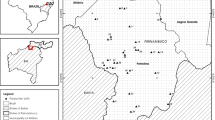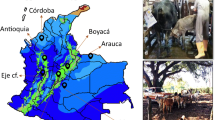Abstract
A total of 350 faecal samples from unweaned alpacas over 3 months of age were collected from 23 herds in order to determine the prevalence of Eimeria spp. in Southern Peru and to identify the risk factors associated to Eimeria infection in young alpacas. Samples were examined by a flotation technique and the identification of risk factors was assessed by a logistic regression analysis. Sixty four percent of the examined animals shed Eimeria oocysts; herd prevalence was 96%, with an intra-herd prevalence of 60% (range 5.9-100%). Five different Eimeria species were identified, being E. lamae (91%), E. alpacae (87%) and E. punoensis (78%) the most prevalent; E. macusaniensis (35%) and E. ivitaensis (13%) were less common. Mixed-species infections were more frequent (78%) than single infections (22%). E. lamae was the most common monospecific infection and E. lamae/E. alpacae the most frequent association. The geographical area has a significant effect on Eimeria infection rates (74.9% wet Puna vs 37.4% dry Puna) as well as the breeding system (65.1% traditional vs 63.8% modern). In contrast, the sex of the animals (64.6% males vs 64.0% females) showed no influence on the prevalence of infection by Eimeria. The high prevalence found at both individual and herd level and the common presence of highly pathogenic Eimeria species may lead to important economic losses for alpaca breeders and could require the implementation of suitable control measures.
Similar content being viewed by others
References
Cabrera M.A. 2008. Resistencia de nematodos gastrointestinales de la familia Trichostrongylidae de las alpacas a los antihelmín-ticos en el Centro y Sur de Perú. PhD Thesis, University of León, Spain
Castillo H., Chávez A., Hoces D., Casas E., Rosadio R., Wheeler J. 2008. Contribución al estudio del parasitismo gastrointestinal en guanacos (Lama guanicoe cacsilensis). Revista de Investigaciones Veterinarias del Perú, 19, 168–175
Cebra C.K., Mattson D.E., Baker R.J., Sonn R.J., Dearing P.L. 2003. Potential pathogens in feces from unweaned llamas and alpacas with diarrhea. Journal of the American Veterinary Medical Association, 223, 1806–1808. DOI: 10.2460/javma.2003. 223.1806
Cebra C.K., Valentine B.A., Schlipf J.W., Bildfell R.J., Mckenzie E., Waitt L.H., Heidel J.R., Cooper B.J., Löhr C.V., Bird K.E., Sauler M.N., Firshman A.M. 2007. Eimeria macusaniensis infection in 15 llamas and 34 alpacas. Journal of the American Veterinary Medical Association, 230, 94–100. DOI: 10.2460/javma.230.1.94
Cid M.D. 2010. Sanidad de alpacas en la etapa neonatal: manual para estudiantes y profesionales de veterinaria. Editorial Complutense, Madrid, Spain, pp.148
Cordero A., Huanca W., Díaz P., López C.M., Panadero R., Fernández G., Lago N., Morrondo P., Díez-Baños P. 2011. Infection by gastrointestinal parasites in alpacas (Lama pacos) from Southern Peru. In: Proceedings of the XII Congreso Ibérico de Parasitología SOCEPA, 5-8 July, 2011, Zaragoza, Spain, 214
Daugschies A., Najdrowski M. 2005. Eimeriosis in Cattle: Current Understanding. Journal of Veterinary Medicine Series B, 52, 417–427. DOI: 10.1111/j.1439-0450.2005.00894.x
FAO 2005. Situación actual de los camélidos sudamericanos en el Perú. Proyecto de Cooperación Técnica de la FAO para el Apoyo a la Crianza y aprovechamiento de los Camélidos Su-damericanos en la Región Andina. Cooperation Project TCP/RLA/2914
Guerrero C.A. 1967. Coccidia (Protozoa: Eimeriidae) of the alpaca Lama pacos. The Journal of Protozoology, 14, 613–616. DOI: 10.1111/j.1550-7408.1967.tb02050.x
Guerrero C.A., Alva J., Leguía G., Bazalar H. 1970. Prevalencia de coccidias (Protozoa: Eimeriidae) en alpacas (Lama pacos). Boletín Extraordinario del Instituto Veterinario de Investigaciones Tropicales y de Altura (IVITA), 4, 84–90
Guerrero C.A., Hernández J., Bazalar H., Alva J. 1971. Eimeria macusaniensis n. sp. (Protozoa: Eimeriidae) of the alpaca Lama pacos. The Journal of Protozoology, 18, 162–163. DOI: 10.1111/j.1550-7408.1971.tb03299.x
Hendrix C.M. 1998. Diagnostic Veterinary Parasitology. Mosby, St Louis, USA, pp.325
Jarvinen J.A. 1999. Prevalence of Eimeria macusaniensis (Apicomplexa: Eimeriidae) in Midwestern Lama spp. The Journal of Parasitology, 85, 373–376. DOI: 10.2307/3285651
Leguía G. 1991. The epidemiology and economic impact of llama parasites. Parasitology Today, 7, 54–56. DOI: 10.1016/0169-4758(91)90190-Y
Leguía G., Casas E. 1998. Eimeria ivitaensis n. sp. (Protozoa: Eimeriidae) en alpacas (Lama pacos). Revista Peruana de Pa-rasitología, 13, 59–61
Leguía G., Casas E. 1999. Enfermedades parasitarias y atlas Parasitológico de camélidos sudamericanos. Ediciones del Mar, Lima, Peru, pp.190
Mamani J., Condeymata Z., Calle L. 2009. Causas de mortalidad de alpacas en tres principales centros de producción ubicados en puna seca y húmeda del departamento de Puno. Revista electrónica de Veterinaria, 10, 1–13
Mckenna P.B. 2006. Eimeria macusaniensis -a brief review. Surveillance, 33, 8–10
Office International des Epizooties (OIE). 2010. Terrestrial Animal Health Code. In: 19 (ed), 2010, (OIE, Geneve, Switzerland).
Palacios C., Perales R., Chavera A., López T. 2005. Caracterización anatomo-histopatológica de enteropatías causantes de mortalidad en crías de alpacas. Revista de Investigaciones Veteri-narias del Perú, 16, 34–40
Palacios C.A., Perales R.A., Chavera A.E., López M.T., Braga W.U., Moro M. 2006. Eimeria macusaniensis and Eimeria ivitaensis co-infection in fatal cases of diarrhoea in young alpacas (Lama pacos) in Peru. Veterinary Record, 158, 344–345. DOI:10.1136/vr.158.10.344
Pellérdy L.P. 1974. Coccidia and coccidiosis. Paul Parey, Berlin, Germany. pp.959
R Core Team 2014. R: A language and environment for statistical computing. R Foundation for Statistical Computing, Vienna, Austria. URL http://www.R-project.org/
Rodríguez A., Casas E., Luna L., Gavidia C., Zanabria V., Rosadio R. 2012. Eimeriosis en crías de alpacas: prevalencia y factores de riesgo. Revista de Investigaciones Veterinarias del Perú, 23, 289–298
Rosadio R., Londoñe P., Pérez D., Castillo H., Véliz A., Llanco L. 2010. Eimeria macusaniensis associated lesions in neonate alpacas dying from enterotoxemia. Veterinary Parasitology, 168, 116–120. DOI:10.1016/j.vetpar.2009.10.010
Tapia M.E. 1996. Ecodesarrollo en los Andes Altos. Fundación Friedrich Ebert. Lima, Peru
Author information
Authors and Affiliations
Corresponding author
Rights and permissions
About this article
Cite this article
Díaz, P., Panadero, R., López, R. et al. Prevalence and risk factors associated to Eimeria spp. infection in unweaned alpacas (Vicugna pacos) from Southern Peru. Acta Parasit. 61, 74–78 (2016). https://doi.org/10.1515/ap-2016-0008
Received:
Revised:
Accepted:
Published:
Issue Date:
DOI: https://doi.org/10.1515/ap-2016-0008




